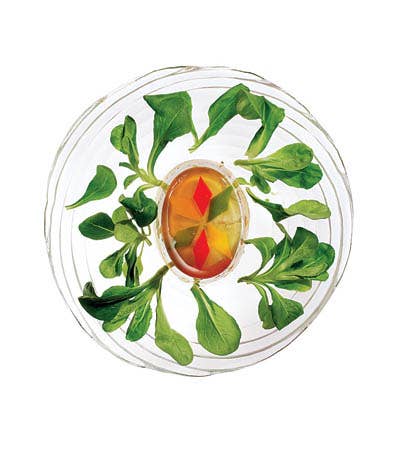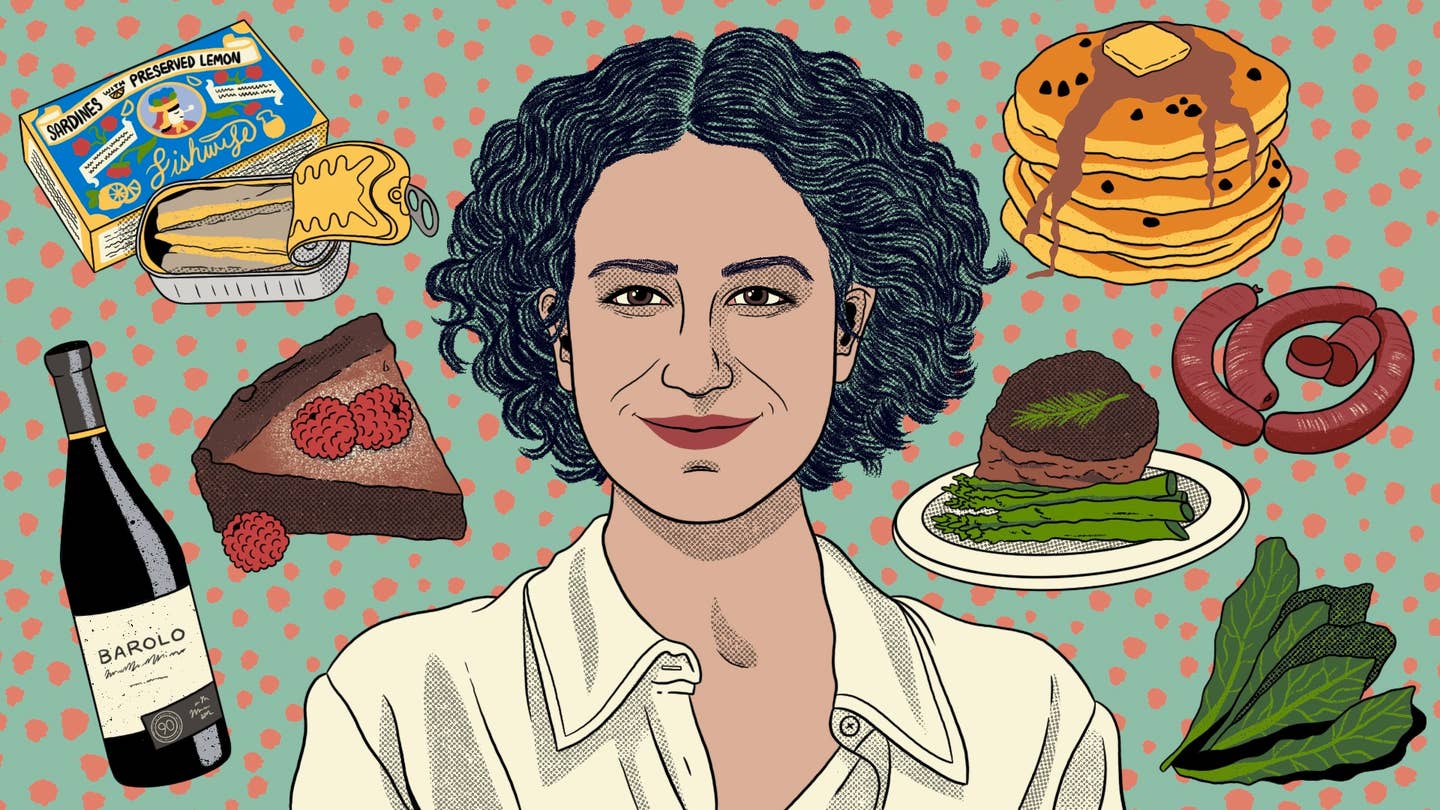
Gelatin: A Thing of Beauty
Forget about pots boiling. I have a corollary to that old kitchen saw: Watched gelatin never sets. At least not for me, and particularly not when I was a line cook a decade ago, working at Chez Panisse in Berkeley, California. During my brief tenure there, it was invariably a test of nerves—from the moment I clocked in until dinner service began—on the days when aspic was on the menu. First, I'd set about making the consomme, a flavorful distillation of beef or chicken stock that had been prepared beforehand. Next, I would bloom sheets of gelatin in cold water before mixing them with the broth. I'd set out several pans, pour a thin layer of liquid into each, and place them in the refrigerator. Then I would wait. Periodically, I'd poke and prod the chilling liquid, fearful that it wouldn't set before dinner—which, thank heavens, it usually did. Just before service, I'd slice and spoon out the glimmering cubes, adding them as a garnish to a terrine or as the main ingredient in a salad so that the aspic's concentrated flavor could mingle with, say, roasted beets and fresh horseradish. As terrifying as the timing was, the results were always stunning. The aspic was shimmering and cool, and it melted so voluptuously in the mouth.
Of course, the gelatin dishes that I'd grown up with were nowhere near as elegant as that. I might have had a thing for black cherry Jell-O as a kid, marveling at the suspended peaches and plums my mother had embedded in it, but by the time I was in my late teens, I'd come to regard that stuff more as camp than as cuisine. My college friends and I made Jell-O, sure, but usually just for vodka shots. And later, when I was an aspiring food snob, if some ambrosia salad, bouncy with canned mandarins and marshmallows, showed up at a holiday potluck, I'd pass it over with a chuckle.
It took me years to understand that there was love in that chuckle, not just mockery. Working with gelatin in restaurant kitchens, I realized that those wobbly, Technicolor American desserts I'd made fun of were actually part of a much grander culinary tradition.
Gelatin is the best known of several ingredients—technically known as hydrocolloids—that can capture food as an unsteady solid. I've used most of them at some point: pectin (derived from fruits) to make preserves, or agar-agar (which comes from sea algae) to make Japanese bean jellies. There are other gelling agents, like xanthan gum and sodium alginate, that are practically unknown to home cooks; they're used by commercial food processors to thicken, stabilize, or otherwise alter the texture of food.
But no hydrocolloid has been as influential in Western cuisine as gelatin, and I am thankful to the nameless soul who first discovered it—perhaps in a bowl of leftover soup. As most home cooks have noticed at one time or another, the juices from cooked meat can gel when chilled overnight. This is because heat causes the twisted strands of collagen, prevalent in skin, connective tissue, and bones, to unwind and mix with cooking liquids; as the liquid cools, the strands tangle, creating a matrix that impedes the movement of water. Gelatin takes form.
Reading old cookbooks, I've always been awed by just how impressive the gelatin molds of yore must have been—I've seen illustrations of ones studded with whole truffles and topped with a statue of cupid—especially considering what people used to have to do to make them. Making gelatin required simmering veal and beef knuckles, bones, and hooves to extract the collagen, clarifying the broth with constant skimming, and then straining it through linen napkins before flavoring it with brandy or herbs and chilling it to set. The process was so laborious, in fact, that by the 19th century, gelatin molds had become a kind of social currency: the finer the house, the blingier the jellies. Such spectacles were nearly impossible to craft outside a well-staffed household or restaurant kitchen.
The process of making gelatin was crying out for a shortcut, and it came in the late 19th century, first in sheet form and then in even easier powdered form, which was popularized by Charles Knox, of Johnstown, New York, who owned a leather glove company and thus had access to plenty of spare animal parts. But it was, of course, Jell-O, the combination of powdered gelatin and fruit flavoring introduced in 1897, that placed gelatin and its molded glories in the hands of the average homemaker. The Jell-O company marketed its product as the modern woman's newest kitchen ally: glimmering and elegant, not too heavy or rich, and quick as a wink to assemble. Soon came dishes like "perfection salad": slivered cabbage, minced peppers, and chopped celery set in luminous aspic, a dish that managed to preserve the most perishable part of dinner in neat, clean, delicious slices. Here were home-style versions of those grand set pieces studded with olives and lobster meat, and, alongside those, whimsical desserts spiked with soda pop or layered with marshmallows.
There was a sheer force of will applied to the jellied dishes of the early and mid-20th century. If a food was eaten at the American table, then a home economist found a way to encase it in gelatin. A quick flip through the vintage recipe brochures I've collected over the years offers forth instructions for making such molded glories as Jellied Bouillon with Frankfurters, Beet Gelatin with Gefilte Fish, Jellied Rhubarb with Walnuts, and Tongue Mousse. Some had sophisticated airs, but just as many were meant to honor thrift and resourcefulness. "Any clever person," wrote Irma Rombauer in the inaugural, 1931 edition of Joy of Cooking (Bobbs-Merrill), "can take a few desolate looking ice box left-overs and glorify them into a tempting Aspic Salad." A survey of the many gelatin recipes in those old publications reveals a fascinating story. It is the tale of a single ingredient that seemingly overnight went from being the most difficult to master to being the easiest.
I eat gelatin dishes often, but the last encounter I had with the jiggly dessert known as Jell-O was in a hospital room, a couple of years ago, when I was recovering from surgery. The setting was emblematic of what has happened to the food's once mighty cachet. Still, I have to admit that while the bright red cherry Jell-O was wildly sweet, it was cool and utterly soothing—a slurp of childhood that was exactly what I needed at the time.
It occurred to me then and there why gelatin is such a powerful and lovable food. It's not just the wink-wink nostalgia of those fanciful Jell-O creations. Nor is it solely the fact that gelatin, in its purest form, has always been relevant in classic and cutting-edge restaurant kitchens, responsible for everything from quivering panna cottas to meat-studded terrines to classic oeufs en gelee (barely cooked eggs encased within aspic). Gelatin is appealing because of its fun wobble, its uncanny texture, its cool refreshment, and its amazing ability to give substance and form to flavors that are usually fleeting. It's a medium as much as it is an ingredient, a liberating tool that brings out the creative cook in us all.
So, I wasn't surprised when I learned, a few years ago, that gelatin plays a fundamental role in the highly technical cooking practiced by avant-garde chefs like Spain's Ferran Adria. His first international sensation was espuma, or foam, a trick made possible by taking a liquid or puree of anything, from espresso to mushrooms, and stabilizing it with gelatin before shooting it out of a pressurized canister designed to whip cream. With their fine, mousseline bubbles and bracing intensity of flavor, those foams made Adria famous, but he kept experimenting, using gelatin and other gelling agents to make dishes that would once have seemed impossible: hot aspics made from agar-agar, for example, or "caviar" made of melon jus encapsulated within a thin jellied skin. The disorientation is part of the fun.
Other chefs have joined Adria in pursuit of improbable textures and flavors, sometimes using those other hydrocolloids that had hitherto been employed only in commercial food processing. But even food futurists like Wylie Dufresne, the chef of the pioneering restaurant wd-50 in New York City, don't slight the appeal of the original hydrocolloid. "It's the only thing in its category that melts when it gets into your mouth," he told me. "Gelatin is the holy grail."
These days, when I spoon a chilly layer of champagne gelee over summer's last flush of berries, I know exactly what he means.
Keep Reading
Continue to Next Story










